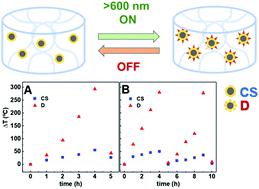当前位置:
X-MOL 学术
›
J. Mater. Chem. B
›
论文详情
Our official English website, www.x-mol.net, welcomes your feedback! (Note: you will need to create a separate account there.)
Dehydropeptide-based plasmonic magnetogels: a supramolecular composite nanosystem for multimodal cancer therapy.
Journal of Materials Chemistry B ( IF 7 ) Pub Date : 2019-11-11 , DOI: 10.1039/c9tb01900f Sérgio R S Veloso 1 , J A Martins 2 , Loic Hilliou 3 , C O Amorim 4 , V S Amaral 4 , B G Almeida 1 , Peter J Jervis 5 , Rute Moreira 6 , David M Pereira 6 , Paulo J G Coutinho 1 , Paula M T Ferreira 2 , Elisabete M S Castanheira 1
Journal of Materials Chemistry B ( IF 7 ) Pub Date : 2019-11-11 , DOI: 10.1039/c9tb01900f Sérgio R S Veloso 1 , J A Martins 2 , Loic Hilliou 3 , C O Amorim 4 , V S Amaral 4 , B G Almeida 1 , Peter J Jervis 5 , Rute Moreira 6 , David M Pereira 6 , Paulo J G Coutinho 1 , Paula M T Ferreira 2 , Elisabete M S Castanheira 1
Affiliation

|
Supramolecular hydrogels are highly promising candidates as biomedical materials owing to their wide array of properties, which can be tailored and modulated. Additionally, their combination with plasmonic/magnetic nanoparticles to form plasmonic magnetogels further improves their potential in biomedical applications through the combination of complementary strategies, such as photothermia, magnetic hyperthermia, photodynamic therapy and magnetic-guided drug delivery. Here, a new dehydropeptide hydrogelator, Npx-L-Met-Z-ΔPhe-OH, was developed and combined with two different plasmonic/magnetic nanoparticle architectures, i.e., core/shell manganese ferrite/gold nanoparticles and gold-decorated manganese ferrite nanoparticles with ca. 55 nm and 45 nm sizes, respectively. The magnetogels were characterized via HR-TEM, FTIR spectroscopy, circular dichroism and rheological assays. The gels were tested as nanocarriers for a model antitumor drug, the natural compound curcumin. The incorporation of the drug in the magnetogel matrices was confirmed through fluorescence-based techniques (FRET, fluorescence anisotropy and quenching). The curcumin release profiles were studied with and without the excitation of the gold plasmon band. The transport of curcumin from the magnetogels towards biomembrane models (small unilamellar vesicles) was assessed via FRET between the fluorescent drug and the lipid probe Nile Red. The developed magnetogels showed promising results for photothermia and photo-triggered drug release. The magnetogels bearing gold-decorated nanoparticles showed the best photothermia properties, while the ones containing core/shell nanoparticles had the best photoinduced curcumin release.
中文翻译:

基于脱氢肽的等离子体磁凝胶:用于多模式癌症治疗的超分子复合纳米系统。
超分子水凝胶因其可定制和调节的广泛特性而成为生物医学材料的极有前途的候选者。此外,它们与等离激元/磁性纳米粒子的结合形成等离激元磁凝胶,通过互补策略(例如光热疗法,磁热疗,光动力疗法和磁导药物递送)的结合,进一步提高了其在生物医学应用中的潜力。在这里,开发了一种新型的脱氢肽水凝胶剂Npx- L -Met - Z -ΔPhe-OH,并将其与两种不同的等离激元/磁性纳米粒子结构结合,即核/壳锰铁氧体/金纳米粒子和金修饰的锰铁氧体纳米粒子约。分别为55 nm和45 nm。磁凝胶通过HR-TEM,FTIR光谱,圆二色性和流变学分析进行了表征。测试凝胶作为模型抗肿瘤药物(天然化合物姜黄素)的纳米载体。通过基于荧光的技术(FRET,荧光各向异性和猝灭)证实了药物在磁凝胶基质中的掺入。研究了姜黄素在金等离子体激元带的激发和不激发下的释放曲线。姜黄素从磁凝胶向生物膜模型(小的单层囊泡)的转运通过荧光药物和脂质探针尼罗红之间的FRET。发达的磁凝胶在光热疗和光触发药物释放方面显示出令人鼓舞的结果。带有金修饰纳米粒子的磁凝胶显示出最佳的光热学性质,而含有核/壳纳米粒子的磁凝胶则具有最佳的光诱导姜黄素释放。
更新日期:2019-11-11
中文翻译:

基于脱氢肽的等离子体磁凝胶:用于多模式癌症治疗的超分子复合纳米系统。
超分子水凝胶因其可定制和调节的广泛特性而成为生物医学材料的极有前途的候选者。此外,它们与等离激元/磁性纳米粒子的结合形成等离激元磁凝胶,通过互补策略(例如光热疗法,磁热疗,光动力疗法和磁导药物递送)的结合,进一步提高了其在生物医学应用中的潜力。在这里,开发了一种新型的脱氢肽水凝胶剂Npx- L -Met - Z -ΔPhe-OH,并将其与两种不同的等离激元/磁性纳米粒子结构结合,即核/壳锰铁氧体/金纳米粒子和金修饰的锰铁氧体纳米粒子约。分别为55 nm和45 nm。磁凝胶通过HR-TEM,FTIR光谱,圆二色性和流变学分析进行了表征。测试凝胶作为模型抗肿瘤药物(天然化合物姜黄素)的纳米载体。通过基于荧光的技术(FRET,荧光各向异性和猝灭)证实了药物在磁凝胶基质中的掺入。研究了姜黄素在金等离子体激元带的激发和不激发下的释放曲线。姜黄素从磁凝胶向生物膜模型(小的单层囊泡)的转运通过荧光药物和脂质探针尼罗红之间的FRET。发达的磁凝胶在光热疗和光触发药物释放方面显示出令人鼓舞的结果。带有金修饰纳米粒子的磁凝胶显示出最佳的光热学性质,而含有核/壳纳米粒子的磁凝胶则具有最佳的光诱导姜黄素释放。



























 京公网安备 11010802027423号
京公网安备 11010802027423号